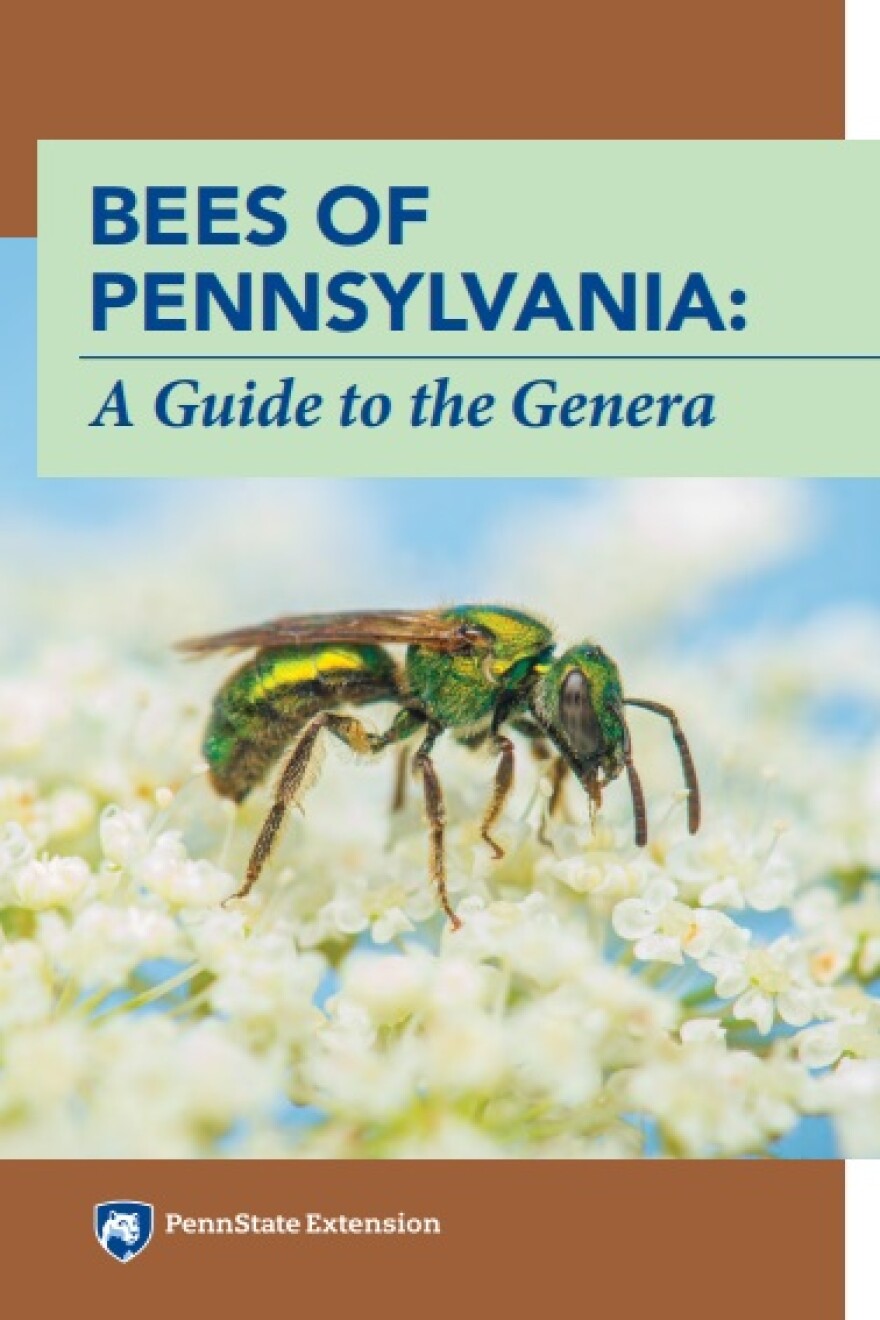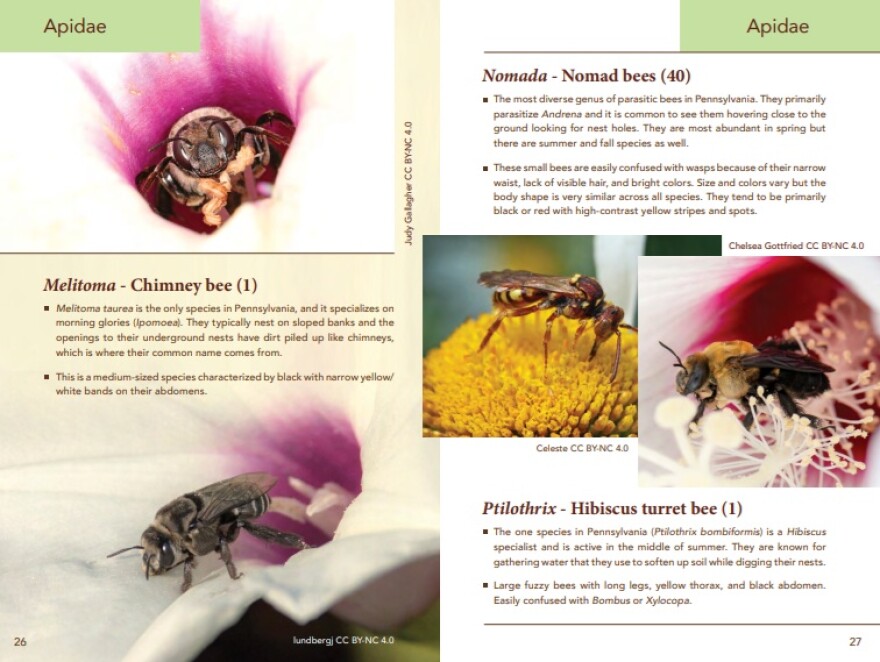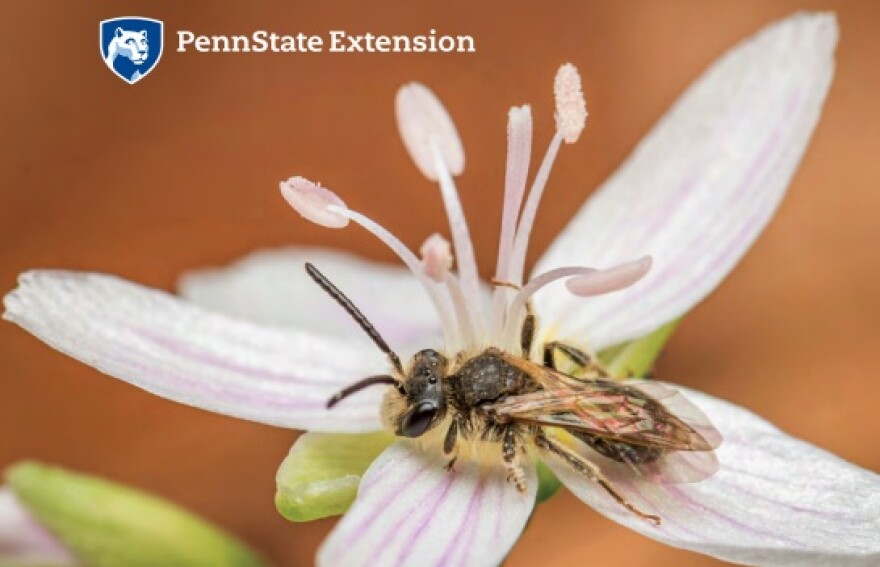BETHLEHEM, Pa. — When it comes to bees, honeybees often get all the attention — but they are just one of hundreds of species of bees in Pennsylvania.
To help residents and enthusiasts explore bee diversity across the state, Penn State Extension this summer published "The Bees of Pennsylvania: A Guide to the Genera.”
It outlines the commonwealth’s more than 440 species of bees, organized by genus.
“There is a shortage of good field guides for bees, and none specifically for Pennsylvania. This guide fills a valuable niche."Muhlenberg College biology professor Marten Edwards
“The diversity is astonishing, and maybe to a person who is not very familiar with bees, many of these things would not even look like a bee,” Penn State entomology professor Margarita López-Uribe said.
Available free in both English and Spanish via digital download or through a limited print run, the guide, co-authored by López-Uribe, includes high-definition photos, facts, detailed descriptions and a table with prevalence, body length, nesting and social preferences, among other traits.
“There is a shortage of good field guides for bees, and none specifically for Pennsylvania,” Muhlenberg College biology professor Marten Edwards said. “This guide fills a valuable niche.
“I will keep this guide handy, especially when I go through my photographs and try to figure out what I was taking pictures of.”

‘To share with everyone’
López-Uribe has studied bees for almost 25 years, focused on understanding how they respond to changes in the environment.
Since 2016, she’s worked at Penn State, documenting patterns of bee biodiversity across the commonwealth.
Residents probably are most familiar with honeybees — a non-native species that's become pivotal to agriculture — but there are so many others hard at work pollinating native plants.
“When we think about all of the plant diversity that is around us, our natural habitats, these other bees are probably most important for pollination to all of those other plants,” López-Uribe said.
“That’s the other cool thing about bees, that they are not only beautiful and diverse, but they're very important because of their role in pollination to both native plants and agricultural plants.”
A recent project aimed at listing the bees of Pennsylvania finished in 2020, she said, with the publication of a checklist of 437 species of bees, including 49 never before recorded in the state.
“The list of bee species keeps growing thanks to the efforts of these community scientists, and we decided to put this book together to share with everyone what we have found.”Margarita López-Uribe, entomology professor at Penn State
“Once we had that baseline information, we established a monitoring program with community scientists to try to fill out some of the gaps that we had in that initial study,” López-Uribe said.
“We started this new program, which we have been running for four years, where master gardeners collect samples near where they live twice per month. They send those samples; we identify them.
“The list of bee species keeps growing thanks to the efforts of these community scientists, and we decided to put this book together to share with everyone what we have found.”
‘Spectacular’
Just shy of 50 pages, the guide was written by several contributors, including: Nash E. Turley, Sarah E. Kania, Stephania Sandoval Arango and Michael J. Skvarla.
It was funded through a grant from the state Department of Agriculture.
After a brief introduction and the table, the guide includes an explanation of taxonomy, the method used by scientists to classify organisms. Then, bees are organized alphabetically, first by family, then by genus.
In addition to the commonly known honey and bumble varieties, there are mining bees, digger bees, cuckoo bees, long-horned bees, sweat bees, blood bees and more.

López-Uribe said residents can use the guide as a reference after spotting a bee outside.
“If you take a good photo of a bee, and you scroll through the pages, I would hope that you could get at maybe some top options for what it may be,” López-Uribe said.
“I would hope that even for non-experts, this could help you get to a smaller group of potential candidates for what that bee really is.”
Edwards said the new guide is “spectacular.”
“Even a quick read provides a stunning tour of the diversity of bees, many of which live on your street,” he said. “Everyone is familiar with honeybees, but most people will be astonished to see the sheer diversity of the other local bees. Some look just like wasps or even shiny jewels.
“In addition to the gorgeous portraits of representatives from 47 branches of the bee family tree, there are handy field notes that will help identify many of the more distinctive ones.
"The pictures are carefully curated to showcase the essential features that would help identify them.”
‘Taking a close look for yourself’
Bees are unique from other pollinators because they rely on pollen and nectar from flowers as their food source.
“It basically obligates bees to go to flowers to look for food and, in that process, they pollinate,” López-Uribe said. “All of the bees on the planet go to flowers to look for food, and in that process, many times they pollinate plants.”
As pollinators, bees are crucial for agriculture, as well as "all the other unpaid services our bees provide, such as their role in food chains and making homes for other organisms,” Edwards said.
“This book introduces us to the importance, beauty and private lives of Pennsylvania’s mostly unnoticed pollinators."Muhlenberg College biology professor Marten Edwards
“This book introduces us to the importance, beauty and private lives of Pennsylvania’s mostly unnoticed pollinators,” he said.
“One of the things that really struck me in this book is how many bees are specific to a single plant. For this reason, bee diversity is at the root of whole communities.”
The process of identification can make a person notice details they might not otherwise see.
“What color are the legs? What is the shape of the face? Which parts are fuzzy, and which parts are bald?” Edwards said. “This kind of close attention lets you see things that are invisible to others. It’s like a superpower.
“You could have your phone do the identification for you, but it would probably give you the wrong answer. There is a huge value in taking a close look for yourself.”
More nuanced questions
With the guide established, researchers now can pose even more nuanced questions.
Asked if there are bee species found only in the Lehigh Valley, López-Uribe said, “I feel like your question is something that we're trying to answer.”
“We do know that different species have different requirements for the type of habitat that they like,” she said.
“Habitat type is a very important driver of communities. We don't have that granular data for Pennsylvania yet, but overall, they are not all the same, so you wouldn't find the same bee species everywhere.”
Edwards said he would recommend the guide to anyone curious about bees.
“Some of the bees that were chosen for this book are very rare, so even a person who has spent a lot of time learning about bees has something new to learn here.”Muhlenberg College biology professor Marten Edwards
“I would especially recommend it to gardeners, photographers, anyone interested in nature, and thirsty to learn more,” he said.
“Some of the bees that were chosen for this book are very rare, so even a person who has spent a lot of time learning about bees has something new to learn here.”
López-Uribe also is looking for feedback from readers, and has created a form to submit comments.For more information, go to Penn State Extension’s website.


